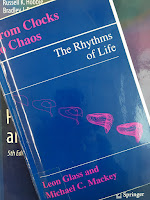The 4th edition of Intermediate Physics for Medicine and Biology doesn’t discuss the structure of DNA much. As Russ Hobbie and I say in the preface, “Molecular biophysics has been almost completely ignored: excellent texts already exist, and this is not our area of expertise.” Yet, we do mention DNA occasionally. In the first section of our book, about distances and sizes, we say
Genetic information is stored in long, helical strands of deoxyribonucleic acid (DNA). DNA is about 2.5 nm wide, and the helix completes a turn every 3.4 nm along its length.
Problem 2 Our genetic information or genome is stored in the parts of the DNA molecule called base pairs. Our genome contains about 3 billion (3×109) base pairs, and there are two copies in each cell. Along the DNA molecule, there is one base pair every one-third of a nanometer. How long would the DNA helix from one cell be if it were stretched out in a line? If the entire DNA molecule were wrapped up into a sphere, what would be the diameter of that sphere?
We discuss DNA again in Chapter 16, when considering radiation damage to tissue.Problem 25 The DNA molecule consists of two intertwined linear chains. Sticking out from each monomer (link in the chain) is one of four bases: adenine (A), guanine (G), thymine (T), or cytosine (C). In the double helix, each base from one strand bonds to a base in the other strand. The correct matches, A–T and G–C, are more tightly bound than are the improper matches. The chain looks something like this, where the last bond shown is an “error.”
A T G C GT A C G A (error)
The probability of an error at 300 K is about 10−9 per base pair. Assume that this probability is determined by a Boltzmann factor e−U/kBT, where U is the additional energy required for a mismatch.(a) Estimate this excess energy.(b) If such mismatches are the sole cause of mutations in an organism, what would the mutation rate be if the temperature were raised 20° C?
Cellular DNA is organized into chromosomes. In order to understand radiation damage to DNA, we must recognize that there are four phases in the cycle of cell division …
Figure 16.33 shows, at different magnifications, a strand of DNA, various intermediate structures which we will not discuss, and a chromosome as seen during the M phase of the cell cycle. The size goes from 2 nm for the DNA double helix to 1400 nm for the chromosome. In addition to cell survival curves one can directly measure chromosome damage. There is strong evidence that radiation, directly or indirectly, breaks a DNA strand. If only one strand is broken, there are efficient mechanisms that repair it over the course of a few hours using the other strand as a template. If both strands are broken, permanent damage results, and the next cell division produces an abnormal chromosome.19 Several forms of abnormal chromosomes are known, depending on where along the strand the damage occurred and how the damaged pieces connected or failed to connect to other chromosome fragments. Many of these chromosomal abnormalities are lethal: the cell either fails to complete its next mitosis, or it fails within the next few divisions. Other abnormalities allow the cell to continue to divide, but they may contribute to a multistep process that sometimes leads to cancer many cell generations later.
 |
| The Double Helix, by James Watson. |
I have never seen Francis Crick in a modest mood. Perhaps in other company he is that way, but I have never had reason so to judge him. It has nothing to do with his present fame. Already he is much talked about, usually with reverence, and someday he may be considered in the category of Rutherford or Bohr. But this was not true when, in the fall of 1951, I came to the Cavendish Laboratory of Cambridge University to join a small group of physicists and chemists working on the three-dimensional structures of proteins. At that time he was thirty-five, yet almost totally unknown. Although some of his closest colleagues realized the value of his quick, penetrating mind and frequently sought his advice, he was often not appreciated, and most people thought he talked too much.
 |
| The Eighth Day of Creation, by Horace Freeland Judson. |
The letter to Nature appeared in the April 25th issue. To those of its readers who were close to the questions, and who had not already heard the news, the letter must have gone off like a string of depth charges in a calm sea. “We wish to suggest a structure for the salt of deoxyribose nucleic acid (D.N.A.). This structure has novel features which are of considerable biological interest,” the letter began; at the end, “It has not escaped our notice that the specific pairing we have postulated immediately suggests a possible copying mechanism for the genetic material.” The last sentence has been called one of the most coy statements in the literature of science.





